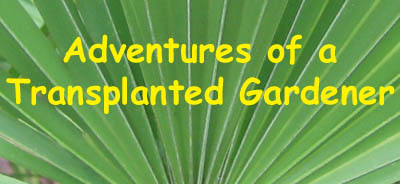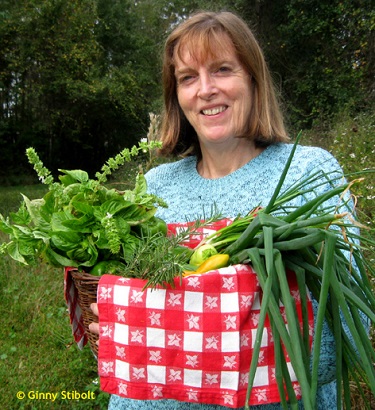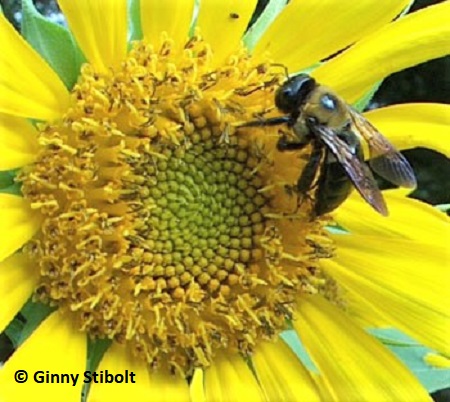|
Adventures of a Transplanted Gardener |
||||||
Sensational sunflowers
| ||||||
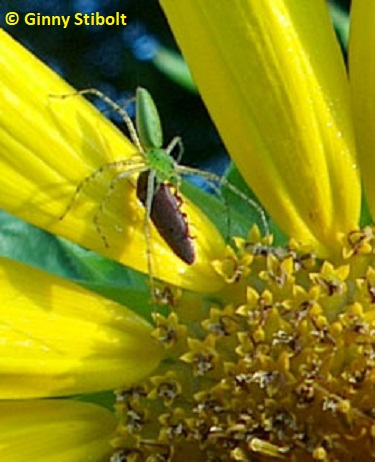 A green spider catches a beetle in the early morning sun. |
Sunflowers belong to the second largest family of flowering plants, asteraceae, also known as the daisies or composites. (The largest is the orchid family.) Sunflowers are typical of the composites; they have the appearance of one big flower, but each flower head (inflorescence) is composed of many florets. In my photos, you can see the numerous disc florets in the center. The sunflower seeds will develop from each disc floret. The sterile, yellow petal-like ray florets radiate from the edge of the head. The big, single-headed varieties will align themselves during the day to follow the sun. There are some members of this family such as dandelions that have all ray florets (obviously not sterile) and there are others with all disc flowers such as the stinking fleabane (Pluchea foetida) growing in our meadow pictured in my last column, but you generally don't notice these disc floret-only plants in the garden-they're just not showy enough.
Globetrotting sunflowers
Sunflowers are native to North America and Native Americans used them in many ways: grinding the seeds for flour, pressing them for oil, or just eating the seeds. They also used the flowers for dye and the seeds in ceremonies. In about 1500 Spanish explorers brought sunflowers back to Europe. Peter-the-Great saw them in the Netherlands in the early 1700s and brought them to Russia. But why did they gain such a toehold there? The Orthodox Church there had strict fasting rules for Lent that forbade the use of certain oils. The centuries-old rules included the specific names for all the known oils: olive, sesame, mustard seed, fish, lard, and more. The list did not include sunflower oils, so the people could obey the church’s strict rules and still use oil. Anyway, people in that part of the world loved the sunflowers and today, the sunflower is Ukraine's national flower. They created many new cultivars, including those mammoths, which are so much fun to grow. Late in the 19th century, these Russian-bred cultivars made the trip back to America. Today the 12-foot Russian mammoths are still a popular hybrid.
One species of sunflower (H. tuberosus) is known as Jerusalem artichoke or sun choke. Native Americans cultivated them for their tubers and called them "sun roots." Champlain, the French explorer, found them in cultivation on Cape Cod early in the 1600s and brought them to Europe. The Italians grew them and called them girasole-meaning follow the sun. That Italian word was carried into English as "Jerusalem" when these cultivars were imported back into the US. Some people think they taste like artichokes, so the name "Jerusalem artichoke" is the common name. These tubers are rich in vitamins and minerals, especially iron. Diabetics often add them to their diet, because they don't contain starch like potatoes, but an indigestible sugar called inulin. You can find them in the produce department of many grocery stores. You can plant the tubers or eat them.
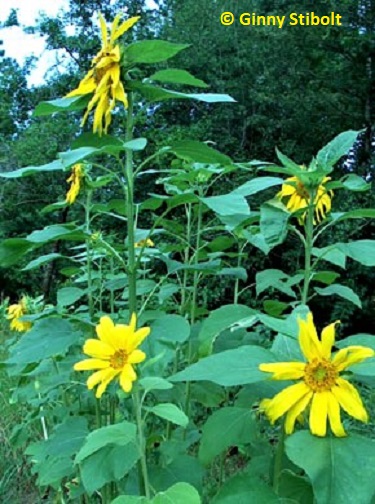 |
Today millions of acres of sunflowers are grown worldwide for oil, seeds, tubers, and for flowers. Pollen-free flowers are popular for the cut flower trade because sunflower pollen stains. And we can't have that!
Our sunflowers
Last year we piled pond muck into an eight-inch thick mound on top of our raised septic drain field to provide more moisture retention. We planted our heritage sunflower seeds directly in the muck. The sunflowers would not have been successful in the very sandy soil on top of the drain field.
They grew from three to six feet tall with only a moderate amount of extra watering. The heads followed the sun each day, with the stems holding the weight of the flowers. These green-eyed flower heads attracted a wonderful array of pollinators; and after the seeds had set, we enjoyed watching the birds feast, too. All in all, a good garden experience.
This year, I ordered three different varieties of sunflowers from American Meadows. I planted them in several areas on our lot. This strategy is part of my education on what works and what doesn't.
I ordered the wild (H. annuus), described in the catalog as,
"... the true grandfather species of them all-the basic annual sunflower that figured so prominently in Native American ritual, fabric making, and foods. Flowers are only about 3-4 inches across, rather like a large, single black-eyed susan on rangy, 3-foot, sandpapery plants."
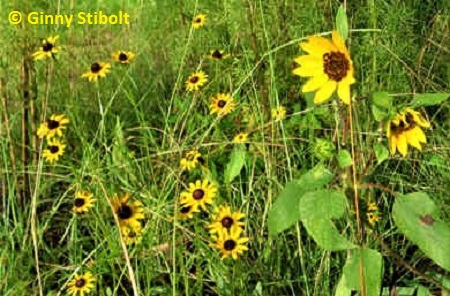 |
<< Here is the wild sunflower with wild black-eyed susans
(Rudbeckia hirta) in the meadow on top of the drain field.
Beautiful. The multi-headed growth habit means that the heads
did not really follow the sun, but it also meant that I could cut the
heads off and new flowers would form. The wild sunflowers grew
from about two feet to four feet tall and the stems have tended to lean
or lie right on the ground. (I guess that's what "rangy"
means.) But still, this wild version was fun to have in our meadows.
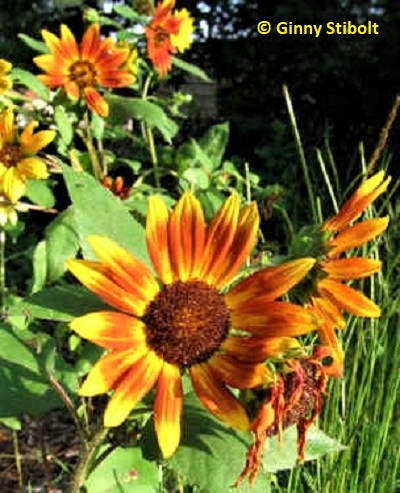 |
The second type is (H. annuus var. A) Autumn Beauty. Here is
the description,
"This strain is famous for its variable flowers. Approximately 5 in. across in yellow, orangy red, gold, deep red, brown, and endless bi-color combinations. This is a popular hybrid mix of colors created from the true grandfather species of them all... Flowers are highly decorative, with small centers and petals that range from pure gold to gold with brown, deep reds, and an unlimited show of color combinations. This is to sunflowers what Gloriosa Daisy is to black-eyed susan. A very popular mix in the cut-flower trade, and a must for your cutting garden."
As advertised, this variety did produce many wonderful color combinations. The flower head was somewhat larger than the wild strain, but it grew to about the same height and had the same leaning problem as the wild species.
The third variety I purchased (H. maximiliania) is a perennial. Here is the description,
"'Maximilian's Sunflower', this is only one of the wonderful, permanent native perennial sunflowers. It is tall, and should be planted at the back of your meadow, or as a clump, not used overall in mixtures. This species will reward you every year with beautiful late blooms, extending your meadow's bloom season. Birds love seed. "
I can see that this narrow-leaved plant will be tall and that it hasn't been in such a rush to bloom as the annuals. Now, in this first week of August, only a few of these plants are beginning to form buds, while the other two varieties have passed their peak. I read in one of the descriptions of the perennial sunflowers that you won't get flowers until the second season-I guess they were not considering our very long growing cycle here in Florida.
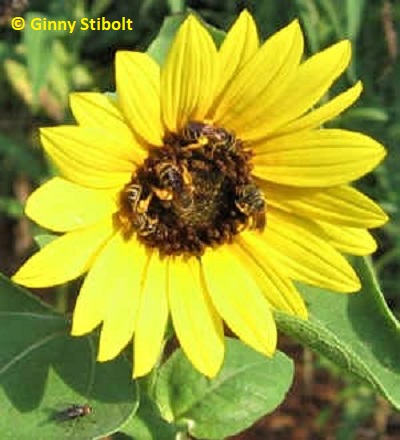 |
<< Bees love this wild sunflower. I wonder what
the fly is collecting down there on the leaf under bees on the flowerhead?
Lessons Learned
1) We used compost as the soil amendment this year, but I think I'll mix in
more pond muck next year for heavier soil and better moisture
retention. Of course, it's been a drier year, so perhaps the compost
mixture would retain adequate moisture in a "normal" season.
2) I think I'll plant half of the annual seeds in early spring for late
spring/early summer flowers and plant the other half in June for late season
flowering.
3) I'll include sun chokes and other perennials in our plan to reduce the
yearly work and to extend the flowering periods. I'll probably need to
transplant some of those tall Maximilian's sunflowers to better locations,
too.
I'd recommend sunflowers for any number of reasons from creating a quick, tall border for your butterfly garden with those Russian Mammoths to fun gardening projects for kids-no patience required. Let me know how your sunflowers grow.
Resources:
· For more detailed history
see: The
National Sunflower Association website.
· For detailed plant profiles see: www.floridata.com/ref/H/heli_tub.cfm.
Ginny Stibolt is a life-long gardener, a botanist, a naturalist, and a garden writer. You may contact her or read more of her articles posted on her website: www.greengardeningmatters.com.
Copyright Ginny Stibolt
